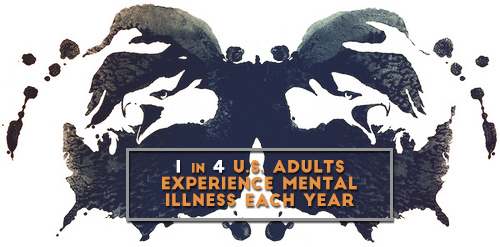Life with a Mental Illness

May is Mental Health Awareness month in the United States and has been since 1949. 31 days out of each year for more than half a century. Sadly, not nearly enough to call sufficient attention to a range of prevalent public health problems that suffer from the scourge of lack of treatment and ubiquitous stigma.
But May is a time for hope as well, as the Pulitzer Prize-winning author Edwin Way Teale once said, “the world’s favorite season is the spring. All things seem possible in May.” As a psychologist myself, I am deeply concerned with the treatment of mental illness in our society, and this month fills me with both hope and consternation. We have made great strides in issues of mental health, but it remains of the utmost importance that we continue to understand the scope and impact of mental illness on our friends, families, and society.
One in four adults in the US experiences a mental illness each year. Put another way, 6.5 million Americans each year are impacted by a mental illness. Furthermore, 60% of adults with a mental illness in 2012 didn’t receive mental health treatment and 90% of people who die by suicide also had a diagnosable mental health condition.
National prevalence data is also a bit hard to come by in terms of who has experienced any type of mental illness in a given year as many individuals do not get screened and do not seek or get care. Stigma surrounding mental health is devastating. Only 25% of adults with mental health symptoms believed that people are caring and sympathetic to persons with mental illness.
In my own research with Latinos in the deep South of the United States, the number one health concern of Latinos was mental illness (Vega, Klukas, Valera, Montenegro, 2015) yet they had extremely limited access to mental health care and also felt ashamed to seek care. Infrastructural barriers and stigma can create an environment in which mental health needs are not given their due attention.
Despite unequivocal gaps surrounding the provision of mental health care we still have not achieved full mental health parity in the U.S. despite Congress passing mental health parity acts. Specifically, mental health parity puts forth that mental health conditions and substance use disorders get equal treatment in insurance plans, like any other health condition. For example, mental health illness and diabetes, when there is parity, are allowed the same coverage (i.e. visits) in plans. However, there are grandfathered plans and Medicaid fee-for-service plans that do not have to follow the federal rules surrounding mental health parity. While we are not there with full parity, we are slowly and painfully moving towards it. Progress is being made in increasing accessibility, availability, affordability and acceptance of mental health care and treatment. We need more and every year that passes where many suffering from mental illnesses go untreated is another missed chance to improve all our lives.
This May, the theme for Mental Health Month is “Life with a Mental Illness”, a call to action for people to share what life with a mental illness feels like for them. Share your need and insights with a provider. Get screened. Get help. There is no shame in reaching for a helping hand when it comes to health, physical, mental, or spiritual needs.
May is a time for celebrating life, examining our lives, and preparing for the joys of summer, and perhaps as the poet Khalil Gibran said, “Be like a flower and turn your face to the sun.” Maybe that’s why May is also National Smile Month in the United Kingdom. By recognizing the need for mental health parity, perhaps we can capitalize on some of the joy in a friend’s smiling face.
